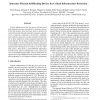Free Online Productivity Tools
i2Speak
i2Symbol
i2OCR
iTex2Img
iWeb2Print
iWeb2Shot
i2Type
iPdf2Split
iPdf2Merge
i2Bopomofo
i2Arabic
i2Style
i2Image
i2PDF
iLatex2Rtf
Sci2ools
DSN
2009
IEEE
2009
IEEE
Intrusion-tolerant self-healing devices for critical infrastructure protection
Critical infrastructures like the power grid are essentially physical processes controlled by electronic devices. In the last decades, these electronic devices started to be controlled remotely through commodity computers, often directly or indirectly connected to the Internet. Therefore, many of these systems are currently exposed to threats similar to those endured by normal computer-based networks on the Internet, but the impact of failure of the former can be much higher to society. This paper presents a demonstration of a family of protection devices for critical information infrastructures developed in the context of the EU CRUTIAL project. These devices, called CRUTIAL Information Switches (CIS), enforce sophisticated access control policies of incoming/outgoing traffic, and are themselves designed with a range of different levels of intrusion-tolerance and self-healing, to serve different resilience requirements.
Computer Networks | Critical Infrastructures | DSN 2009 | Electronic Devices | Normal Computer-based Networks |
| Added | 20 May 2010 |
| Updated | 20 May 2010 |
| Type | Conference |
| Year | 2009 |
| Where | DSN |
| Authors | Paulo Sousa, Alysson Neves Bessani, Wagner Saback Dantas, Fabio Souto, Miguel Correia, Nuno Ferreira Neves |
Comments (0)

